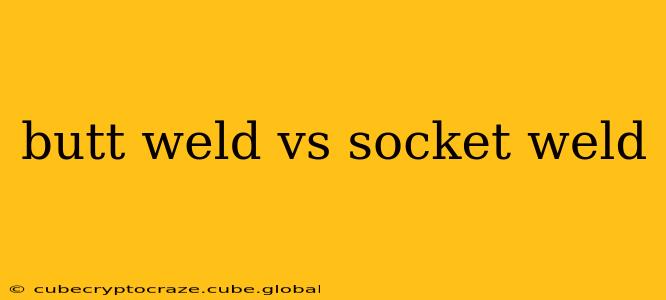Choosing the right welding technique is crucial in piping systems, impacting strength, reliability, and overall project cost. Butt welds and socket welds are two common methods, each with its own strengths and weaknesses. This comprehensive guide explores the key differences between butt welds and socket welds, helping you make informed decisions for your specific application.
What is a Butt Weld?
A butt weld is a type of fusion weld where the edges of two separate pieces of pipe are joined directly together, creating a continuous and seamless joint. This method is preferred for its high strength and minimal restriction to fluid flow. Butt welds are typically used in larger diameter pipes and high-pressure applications where maximum strength and integrity are paramount. The process often requires more precise preparation and skilled welders to ensure a high-quality, leak-free joint.
What is a Socket Weld?
In contrast, a socket weld involves inserting one pipe end into a socket or recess on another pipe fitting. A smaller diameter pipe is typically used with this method. The joint is then welded around the exterior of the socket. Socket welds offer ease of assembly and require less welding preparation compared to butt welds. However, they generally have lower strength and may restrict fluid flow more due to the added volume of the socket.
Butt Weld vs. Socket Weld: Key Differences Summarized
| Feature | Butt Weld | Socket Weld |
|---|---|---|
| Joint Design | Direct joining of pipe edges | One pipe end inserted into a socket |
| Strength | Higher strength, suitable for high pressure | Lower strength, generally lower pressure |
| Flow Restriction | Minimal | Moderate |
| Welding Prep | More complex, requires precise edge preparation | Less complex, minimal preparation needed |
| Assembly | More difficult, requires skilled welders | Easier, can be done with less skilled labor |
| Pipe Size | Typically used for larger diameter pipes | Typically used for smaller diameter pipes |
| Cost | Generally higher cost due to labor and prep | Generally lower cost |
Which Weld Type Should I Choose?
The best choice between butt welding and socket welding depends heavily on several factors:
- Pressure and Temperature Requirements: High-pressure and high-temperature applications typically necessitate the superior strength of a butt weld.
- Pipe Size and Material: Socket welds are more commonly used with smaller diameter pipes, while larger diameter pipes often require butt welds.
- Project Budget and Timeline: Socket welds generally offer faster assembly and lower labor costs.
- Welding Expertise: Butt welds demand skilled welders capable of achieving precise edge preparation and fusion.
What are the advantages of butt welding?
Butt welding offers significant advantages, including superior strength and minimal flow restriction, making it ideal for high-pressure, high-temperature applications.
What are the advantages of socket welding?
Socket welding provides benefits such as ease of assembly and lower labor costs, making it suitable for applications where high strength is not the primary concern.
What are the disadvantages of butt welding?
The primary drawbacks of butt welding include its increased complexity, requirement for specialized welders, and higher labor costs.
What are the disadvantages of socket welding?
Socket welding has lower strength compared to butt welding and might introduce some flow restriction.
Which is stronger, butt weld or socket weld?
Butt welds are significantly stronger than socket welds, making them suitable for high-pressure and high-temperature applications.
When is socket welding preferred?
Socket welding is preferred for smaller diameter pipes, situations where ease of assembly and lower costs are prioritized over ultimate strength.
Is socket welding suitable for high pressure?
Generally, socket welding is not recommended for high-pressure applications due to its lower strength compared to butt welds.
By carefully considering these factors, you can choose the welding method that best aligns with your project's needs, ensuring both safety and efficiency. Consulting with experienced piping engineers and welders is always recommended to ensure the proper selection and execution of the welding process.
